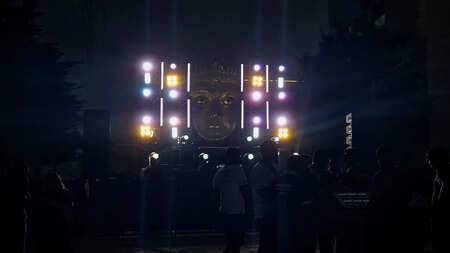The Demon Core: A tragic tale of nuclear experiments
Times of Bennett | Updated: Apr 19, 2023 15:41

By Jai Goyal
The year was 1945, and amidst the chaos of World War II, a top-secret laboratory in Los Alamos, New Mexico was abuzz with cutting-edge scientific research. Inside its hallowed walls, a mysterious and deadly substance known as theDemon Core was being studied - a sphere of plutonium that held immense power and unimaginable risks.
TheDemon Core was no ordinary material. It was the same plutonium that had been used in the atomic bomb that devastated Hiroshima and brought the war to a devastating end. But the scientists at the laboratory didn't stop there. Driven by curiosity, they continued their experiments with the Demon Core, eager to unlock its secrets and harness its potential.
However, the Demon Core was not to be trifled with. It emitted lethal amounts of radiation, with gamma rays that could penetrate through flesh and bone. The air around it glowed an eerie blue, a haunting reminder of its immense power. Yet, in their pursuit of knowledge, the scientists at the laboratory took calculated risks, pushing the limits of safety.
Then, on a fateful day in August 1945, disaster struck.Harry Daghlian , a young physicist, accidentally dropped a brick of tungsten carbide onto the Demon Core. The blue glow intensified, and Daghlian received a deadly dose of radiation. Despite valiant efforts to save him, he succumbed to the radiation's ravaging effects after 25 agonizing days, becoming the first victim of the Demon Core.
The incident sent shockwaves through the laboratory, but the lessons were not heeded. Just nine months later, tragedy struck again.Louis Slotin , another scientist, was conducting a similar experiment with the Demon Core. With a screwdriver in hand, he attempted to separate the halves of a beryllium shell that surrounded the core, a practice known as "tickling the dragon's tail." But in a heartbeat, the screwdriver slipped, and the Demon Core went critical once more, releasing a deadly burst of radiation.
Slotin 's instincts kicked in, and he used his own body as a shield to protect his colleagues from the lethal radiation. His heroic act saved their lives, but it came at a great cost. Slotin received a lethal dose of radiation, and despite desperate efforts to save him, he succumbed to the agonizing effects after nine days, becoming the second victim of the Demon Core.
The aftermath of the incidents was devastating. The losses of Daghlian and Slotin were a stark reminder of the unforgiving nature of radiation and the dire consequences of mishandlingnuclear materials. The incidents triggered widespread changes in safety protocols and regulations in nuclear laboratories across the world, aimed at preventing such tragedies from ever happening again.
The legacy of the Demon Core lives on as a sombre reminder of the risks and responsibilities associated with nuclear research. It serves as a cautionary tale about the perils of complacency and the need for utmost vigilance in scientificexperiments , especially those involving radioactive materials. The sacrifices of Daghlian and Slotin will forever be remembered, their tragic deaths leaving an indelible mark on the field of nuclear safety.
In the end, the story of the Demon Core is a haunting tale of nuclear experimentation gone wrong. It serves as a sobering reminder of the devastating consequences of mishandling radioactive materials and the importance of safety and responsibility in scientific endeavours. The losses of Daghlian and Slotin are a grim reminder of the dark legacy of the Demon Core, a cautionary tale that echoes through the annals of history, reminding us to tread carefully when delving into the mysteries of the atomic world.
The year was 1945, and amidst the chaos of World War II, a top-secret laboratory in Los Alamos, New Mexico was abuzz with cutting-edge scientific research. Inside its hallowed walls, a mysterious and deadly substance known as the
The
However, the Demon Core was not to be trifled with. It emitted lethal amounts of radiation, with gamma rays that could penetrate through flesh and bone. The air around it glowed an eerie blue, a haunting reminder of its immense power. Yet, in their pursuit of knowledge, the scientists at the laboratory took calculated risks, pushing the limits of safety.
Then, on a fateful day in August 1945, disaster struck.
The incident sent shockwaves through the laboratory, but the lessons were not heeded. Just nine months later, tragedy struck again.
The aftermath of the incidents was devastating. The losses of Daghlian and Slotin were a stark reminder of the unforgiving nature of radiation and the dire consequences of mishandling
The legacy of the Demon Core lives on as a sombre reminder of the risks and responsibilities associated with nuclear research. It serves as a cautionary tale about the perils of complacency and the need for utmost vigilance in scientific
In the end, the story of the Demon Core is a haunting tale of nuclear experimentation gone wrong. It serves as a sobering reminder of the devastating consequences of mishandling radioactive materials and the importance of safety and responsibility in scientific endeavours. The losses of Daghlian and Slotin are a grim reminder of the dark legacy of the Demon Core, a cautionary tale that echoes through the annals of history, reminding us to tread carefully when delving into the mysteries of the atomic world.







